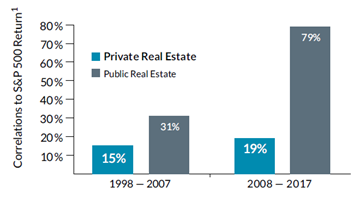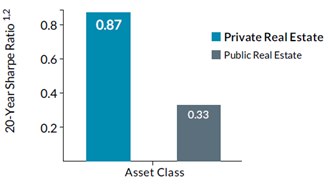
Today’s investors are challenged to find yield in a low-rate environment and appreciation potential in a world of highly valued equities. They are increasingly looking to alternatives to meet their financial objectives. When investing in alternatives, however, some of the greatest challenges for an investor are determining the true level of risk being taken and assessing what is an acceptable rate of return for that level of risk.
In public securities, risk is often couched in terms of volatility. But for illiquid private investment vehicles, risk is more likely to be defined as the likelihood of a permanent loss of capital. Each definition can be applicable to a particular situation, but defining risk is more multi-faceted than this, and return targets surely aren’t all created equal.
As we will describe below, there are times when a seemingly mundane investment with a 12% target IRR is just what a portfolio needs.
Embracing Illiquidity Risk
In addition to bearing the risk of loss, investors in private securities face a lack of trading liquidity. The lack of a daily mark-to-market valuation can make private investments a stabilizing factor in a portfolio, at least over the short term. While surely not an indication of a lower risk level, this draws attention to the weakness of using volatility as a primary measure of risk. It also highlights how public securities can react strongly to market and economic factors, adding to portfolio volatility, while private valuations are much slower to change and are driven by operating fundamentals more than by short term views.

Even if one assumes that illiquidity delivers a possible benefit to offset investor emotions, an investor should still be compensated for the lack of trading liquidity of any investment. In practice, it seems that we usually are. An example of private real estate investments versus publicly traded REITs shows a yield premium of more than one percent for private funds and a far lower correlation of returns with the S&P500 (shown at right).

Likewise, a comparison (at left) of the Sharpe Ratio of public versus private real estate shows that the private investment has delivered more return for each unit of risk.
The concept of illiquidity risk circles back to the concern over volatility: Both are risks that an investor may have an unexpected need for funds (either from true need or emotional reaction) and may find it necessary to liquidate investments at the worst possible time. But the investor who can accurately forecast their liquidity requirements has an inherent advantage. Rather than being concerned over the illiquidity of a part of their portfolio, they can budget for the amount that needs to remain liquid (and subject to the volatility of the financial markets) with the remainder focused on the long term and earning an “illiquidity premium” and potentially higher returns.
In short, turning the liquidity question on its head could yield a portfolio with a more efficient risk/return tradeoff.
Reducing of Correlation Risk
While investors may be compensated for illiquidity, they are not usually compensated for incurring correlated risks (i.e., the risk that two investments behave in the same way at exactly the worst time.) When an investor expands their opportunity set by including private investments, they increase the likelihood that they can incorporate vehicles that have a lower correlation of returns.
In practice, correlation risk can and should be diversified away where possible, but this aspect of investing is often neglected when investors put on their “deal hat” and not their “portfolio hat”. When taking a portfolio perspective, it becomes clear that identical 12% target IRRs are NOT of equal value if one of them is highly correlated with existing positions. Adding true diversifiers with the same target return improves portfolio efficiency, again delivering more potential return for each unit of risk.
It is also important to view each investment’s target IRR as a central point amid a range of possible outcomes, some of which may be negative. And when the same risk factors (i.e., interest rates or economic growth) are the main drivers of returns for more than one investment, the investor may be multiplying their risks despite investing in what appear to be thematically different stories.
Portfolio management is therefore about trade-offs, and where possible, about upgrading portfolios to perform better over time for the risks that are being taken. Investments aren’t viewed in a vacuum, but rather in comparison with existing holdings and possible alternatives.
With stock returns having averaged 10% per annum over the past 50 years, an alternative investment fund with a 12% target IRR and no correlation to the S&P500 can look like a winner for an investor who can allocate to private alts. With US large cap equities at elevated valuations, the case for alternatives is even stronger.
Seeking “Alpha” and “Beta”
At Altera, we assess an investment’s return potential and its risks, looking at both the broad asset class and the specifics of the investment itself. Our process tends to produce eclectic investment vehicles where one of the largest risks factors is often manager execution. We focus not just on getting the “beta” (return of the asset class), but also on finding those independent sources of “alpha” that add value through execution in a specific segment at a particular point in time.
For example, “manager execution” might be delivered by improving the profitability of a self-storage facility after acquisition, increasing its yield and its market value. It might be in the selective acquisition of underperforming hotels or in a manager’s process of acquiring so-called “dull” companies at low valuations and providing capital to consolidate other competitors into a larger, more valuable entity.
In these examples, manager execution is about more than owning an asset and riding the wave of a market cycle or organic growth. It is about making more from what’s there, adding to the potential return of an investment, independently of the macro factors at work. When investors can earn alpha (from the value-add) and beta (from the asset class), their chances of earning returns that are less correlated with their other investments increases greatly.
The conclusion is that a portfolio mindset seeks diversification of certain types of risk, attempting to minimize some while embracing others. By specifically targeting different sources of alpha, this process could deliver a better outcome over the long term, even while incorporating the occasional 12% IRR fund.
1 Sources: Bloomberg, NCREIF, NAREIT 20 years ended 12/31/2017.
2 The Sharpe Ratio is a measure of excess return on an asset above a risk-free rate relative to the standard deviation of return of that asset.
3 JPMorgan 2021 | 25th Annual Edition — Long-Term Capital Market Assumptions